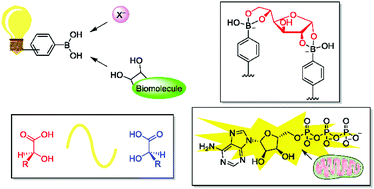Recent advances in boronic acid-based optical chemosensors
Abstract
Reversible covalent binding of boronic acids with polyols and Lewis bases has facilitated the development of robust chemosensors for many biologically important species under physiologically or environmentally relevant conditions. This minireview covers selected examples of advances reported in this area from 2014 to 2016. While the discovery of new boron-containing binding motifs and identification of new analytical targets have expanded the ultility of boronic acid-based molecular recognition, unconventional sensing strategies such as exploitation of nanoscale self-assembly, multicomponent dynamic covalent assembly, and coupling boronate ester formation with a further chemical reaction have led to significantly improved sensor performance, enabling real-world applications in various areas such as cell biology and asymmetric catalysis.

- This article is part of the themed collections: Optical Biosensor Devices, Bioanalytical Sensors and Analyst 2017 Most Downloaded Articles


 Please wait while we load your content...
Please wait while we load your content...